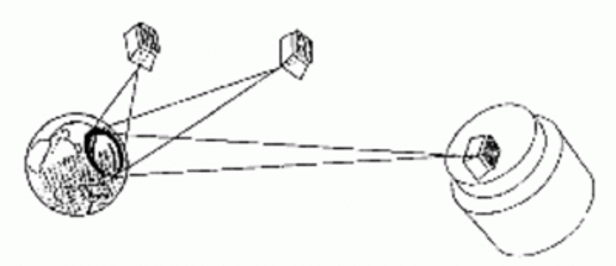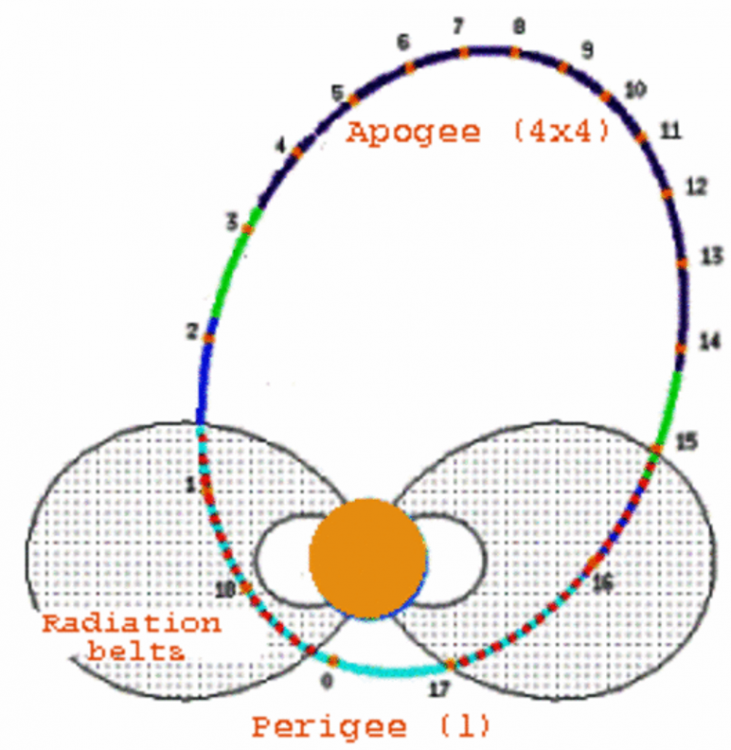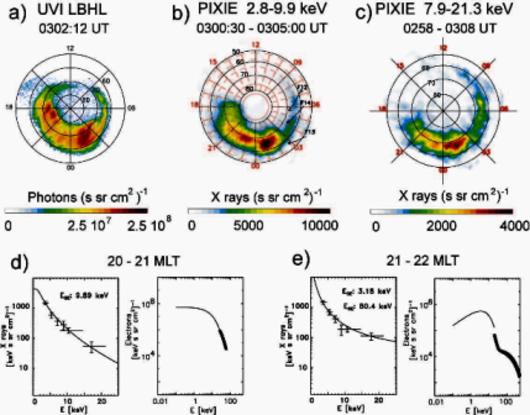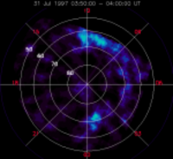PIXIE
PIXIE is an auroral imager operating on x-ray wavelengths corresponding to energies between 2 and 60 keV. It will monitor the spatial and temporal distribution of precipitating high energy electrons from space into the upper atmosphere. Observations can be made on the day side as well as on the night side of the Earth, and the measurements can provide height profiles of the ionization, electron density and conductivity at each point of the image.
These are global x-ray images of the Earth’s aurora over the North Pole (left) and the South Pole (right), on 9 February 1997 and 25 September 1998, respectively. The pictures were taken by the PIXIE Imager aboard the NASA/POLAR satellite, and are presented in false colour with the colour corresponding to the measured x-ray intensity from blue (weakest) through red (strongest).

The x-ray energy range covered by these images is from about 2 keV to over 10 keV. When energetic electrons from the Earth’s magnetosphere struck the upper atmosphere these x-rays were emitted. The intensity of the x-rays is directly related to the intensity of the precipitated electron flux.
The images illustrate one of the advantages of x-ray imaging of the aurora: insensitivity to sunshine. The day/night terminator is indicated by a dashed red line. In the left picture, Norway and Siberia are in darkness and Alaska and Canada are in the sunlight. The most intense auroral x-ray emission region is in the local time zone just after midnight in the north. The picture of the southern aurora shows the most intense x-ray emissions on the morning side.
The image over the North Pole was made with a five minute exposure time, whereas the image over the South Pole had an exposure time of only 20 seconds. The orbit of the Polar spacecraft was at this time when the pictures were taken, 8 Earth radii (~50 000 km) above the North Pole at the most, and just 0.8 Earth radii (~5000 km) above the South Pole.
Background
Instrument
Research: Background
Research: Chemical effects of electron precipitation
Research: Energy deposition
Research: Energy flow
Research: Substorm dynamics
Research: Substorms
History
Publications
The PIXIE camera is based on pinhole optics with multiwire proportional chambers as detecting elements, as illustrated in this schematic diagram.

Proportional Chambers
The detecting element in PIXIE is two stacked proportional chambers. The front chamber has a 0.1 mm beryllium entrance window. Inside are two counter sections (two anode wire planes stacked between three cathode wire planes) operating in a 90% argon + 10% carbondioxid gas at 1 atmosphere. The rear chamber has a 2.0 mm beryllium entrance window. Its mechanical design is identical to the front chamber, but the chamber gas is a 90% xenon + 10% carbondioxid admixture at 2 atmospheres. The detector system is sensitive to x-rays in the 2 to 60 keV range. When x-ray photons are absorbed in the chamber gas the anode signal provides information on the photon energy while the cathodes supplies position information. To minimize the number of components and thereby minimize the contamination of the chamber gases the position readout system was based on graded density cathodes.
Wire Frames
The mechanical workshop at the Department of Physics and Technology manufactured 24 wire frame bodies of flight quality for PIXIE. Their dimensions are 262.0 x 262.0 x 5.50 mm, and they are made of a fibre glass epoxy material, Stesalit, (Stesalit AG, Switzerland). The critical mechanical tolerances are 0.02 mm. Gold plated tungsten wires (Luma Metall, Lumalampan AB, Sweden) and electronic components were mounted on the frame bodies under clean room conditions. Five frames were installed in each of the two proportional chambers on PIXIE. Some wire frame parameters are given in the table:
Anodes Center cathode Top and bottom cathodes
| Active detector area: Anode – cathode separation: |
180 mm x 180 mm 5.50 mm |
||
| Anodes | Center cathode | Top & bottom cathodes |
|
| Number of signal wires: Signal wire diameter: Number of edge wires: Edge wire diameter: Wire separation: |
86 12.5 µm 2+2 12.5 µm 2 mm |
175 50 µm 2+2 100 µm 1 mm |
175 30 µm 2+2 100 µm 1 mm |
| Wire material: | Gold plated W (97%), Re (3%) | ||
Orbit
The 1.8 x 9 Re polar orbit and 18 hours period of the POLAR spacecraft allows PIXIE to monitor the x-ray aurora of the northern polar hemisphere for more than 10 hours continuously. The instrument is turned off while in the radiation belts.

The distance from the spacecraft to the Earth’s atmosphere is varying by about a factor of 10 as POLAR moves in its orbit, and the image created in the detector plane by one pin hole varies in size accordingly. However, by changing the number of open pin holes as a function of the spacecraft altitude, a “zooming” effect is obtained, and the detector area is used effectively at all altitudes. The sizes of the pin holes can be varied in order to optimize the temporal and spatial resolution of the imager.

There are six main topics we focus on:
1. Energy deposition by precipitating electrons and how ith affects ionospheric electrodynamics
- Multi-spectral global imaging is used to derive information on energy characteristics of the precipitating electrons and protons. By combining global ultraviolet emission- and x-ray observations we derive electron energy spectra in the energy range from 100 eV to 100 keV on a global scale.
- The ability for the atmosphere to transfer electric charge (conductivity) can be derived from the energy distribution of the precipitating electrons.
2. Electron precipitation – dynamics and special features
- The dynamics of an x-ray substorm with dawnward auroral motion, where maximum is delayed relative to substorm onset.
- Dayside observations of high latitude energetic precipitaion, combined with riometer, allsky camera, photometers and magnetometers.
- Global observations of pulsating aurora over the South Pole.
3. Energy flow – Solar wind -> ionosphere
- How much of the available solar wind energy is transferred to the magnetosphere/ionosphere system of the Earth?
4. Chemical effects of electron precipitation
The energetic electrons that penetrate into Earth’s atmosphere cause chemical changes of the atmospheric composition as they interact with the atoms, ions and molecules there. The interaction could also give dynamic effects (wind, turbulence and waves) and temperature changes.
The global images of the precipitation intensity derived from PIXIE has been compared with the increase of nitric oxide in the upper atmosphere.
5. Substorms
Possible onset triggering mechanisms and scenarios for substorms have been studied.
6. Auroral signatures from the X-line? (Cluster and PIXIE)
An X-line is an area where magnetic energy is transformed into kinetic energy. PIXIE has been used to study possible auroral signatures from an X-line observed by the Cluster satellites in the Earth’s magnetic tail.
Research: Chemical effects of electron precipitationSection 4
The highly energetic electrons that enter our atmosphere from above cause many chemical changes in the atmospheric gasses. The energy the electrons carry will be transferred to the molecules, atoms and ions in the atmosphere. This may cause heating, initiation of chemical reactions, which again can give more radiation loss. Also the chemical composition might be altered, and there could be dynamical effects such as waves, winds and turbulence.
By using the x-ray measurements from PIXIE, we can find on a global scale where and how much energy that has been transferred from the precipitating electrons.
A chemical effect of electron precipitation is the increase of nitric oxide (NO) in the lower thermosphere. Energy from the incoming electrons is transferred to nitrogen molecules, splitting them into nitrogen atoms which can react with oxygen molecules to form nitric oxide.
Thermospheric NO has a lifetime of approximately one day. The Student Nitric Oxide Explorer (SNOE) measured the NO-density by observing emissions of NO in the dayglow (the image on the right). We here in Bergen have compared the time-integrated x-ray intensity accumulated for the entire night, with the NO density observed on the dayside. The results showed a quite good correlation.
C. Sætre, J. Stadsnes, H. Nesse, A. Aksnes, S. M. Petrinec, C. A. Barth, D. N. Baker, R. R. Vondrak, and N. Østgaard (2004), Energetic electron precipitation and the NO abundance in the upper atmosphere: A direct comparison during a geomagnetic storm, J. Geophys. Res., 109, A09302, doi:10.1029/2004JA010485.
[pdf]
C. Sætre, C. A. Barth, J. Stadsnes, N.Østgaard, S. M. Bailey, D. N. Baker and J. W. Gjerloev. Comparisons of electron deposition derived from observations of lower thermospheric nitric oxide and from X-ray bremsstrahlung measurements. J. Geophys. Res., Vol. 111, A04302, doi:10.1029/2005JA011391, 2006.
Research: Energy depositionSection 5
Energy deposition by precipitating electrons and how it affects ionospheric electrodynamics
Techniques: Multi-spectral global imaging is a strong tool to derive information about the energy characteristics of precipitating electrons and protons. We have shown that the combined measurements of ultraviolet emissions and X-rays from space can be used to derive electron spectra in the energy range from 100 eV to 100 keV on a global scale. We have also shown that the techniques give results that are consistent with insitu particle measurements from low-altitude spacecraft.
N.Ostgaard, J. Stadsnes, J. Bjordal, G. A. Germany, R. R. Vondrak, G. K. Parks, S. A Cummer, D. L. Chenette, J. G. Pronko, Auroral electron distributions derived from combined UV and X-ray emissions. J. Geophys. Res., Vol.106, 26,081 – 26,090, 2001.
Energy deposition from electron precipitation as a function of geomagnetic indices: We have also examined how the hemispherical energy deposition (0.1-100 keV) relates to the geomagnetic indices AL and AE and presented simple expressions that can be used when global imaging is not available.
N. Ostgaard, R. R. Vondrak, J. W. Gjerloev, G. A. Germany, A relation between the energy deposition by electron precipitation and geomagnetic indices during substorms. J. Geophys. Res., Vol. 107, NO. A9, 1233, doi: 10.1029/2001JA002003, 2002.
Electron precipitation and ionospheric conductances:
From remote sensing of UV and X-ray emissions by the UVI and PIXIE cameras onboard the Polar satellite, we derive global maps of the precipitating electron energy spectra from less than 1 keV to 100 keV. Based on the electron spectra, we infer height profiles of the resulting ionization. Photo ionization is also included in these calculations. We then generate instantaneous global maps of the Hall and Pedersen conductances. This technique allows us to study the time development of the conductances during geomagnetic substorms.
A. Aksnes, J. Stadsnes, J. Bjordal, N. Østgaard, R. R. Vondrak, D. L. Detrick, T. J. Rosenberg, G. A. Germany, and D. Chenette, Instantaneous ionospheric global conductance maps during an isolated substorm. Annales Geophysicae, 20, 1181, 2002.
Remote sensing of UV emissions gives good coverage of the precipitating electrons in the energy range of a few keV, responsible for the Pedersen conductance. X-ray measurements are needed to capture the high-energy tail of the energetic electrons from some tens of keV and up to 100 keV affecting the Hall conductance. The PIXIE X-ray camera on the Polar satellite is the only instrument providing global information about the energetic electron precipitation. Instantaneous global conductance maps derived with and without the inclusion of PIXIE X-ray data have been implemented in the Assimilative Mapping of Ionospheric Electrodynamics (AMIE) procedure to study the effects of energetic electrons on the ionospheric electrodynamics. This includes ionospheric conductances, the ionospheric electric field, the atmospheric Joule heating, and the auroral energy flux.
A. Aksnes, J. Stadsnes, G. Lu, N. Østgaard, R. R. Vondrak, D. L. Detrick, T. J. Rosenberg, G. A. Germany, and M. Schulz, Effects of energetic electrons on the electrodynamics in the ionosphere. Annales Geophysicae, 22, 475, 2004.
The method of characteristics is a ground-based technique to derive the ionospheric conductances, using electric field measurements and ground magnetometer data. We have derived and compared conductances above Northern Scandinavia using method of characteristics (the MIRACLE network) and remote sensing of UV and X-ray emissions (UVI and PIXIE on the Polar satellite).
A. Aksnes, O. Amm, J. Stadsnes, N. Østgaard, G. A. Germany, R. R. Vondrak, and I. Sillanpaa, Ionospheric conductances derived from satellite measurements of auroral UV and X-ray emissions, and ground-based electromagnetic data: A comparison. Accepted for publication in Annales Geophysicae, 2004.
Another study the group in Bergen has participated in is the analysis of mesoscale ionospheric electrodynamics of omega bands. An omega band is an auroral phenomena typically occurring on the morning side diffuse aurora in the recovery phase of substorms. Auroral omega bands are periodic, wave-like undulations of the poleward boundary of the aurora, and the name omega is due to the dark areas between the auroral tongues, which resemble the form of the inverted capital Greek letter. We use ground-based electromagnetic data from the MIRACLE and BEAR networks and satellite optical observations from the UVI and PIXIE instruments on the Polar satellite to study the ionospheric electrodynamics during an omega band event over Northern Scandinavia.
Amm, A. Aksnes, J. Stadsnes, N. Østgaard, R. R. Vondrak, G. A. Germany, G. Lu, and A. Viljanen, Mesoscale ionospheric electrodynamics of omega bands determined from ground-based electronmagnetic and satellite optical observation. Accepted for publication in Annales Geophysicae, 2004.
Amm, A. Aksnes, J. Stadsnes, N. Østgaard, R. R. Vondrak, G. A. Germany, and I. Sillanpaa, Observations and analysis of ionospheric electrodynamics during a substorm recovery phase using the MIRACLE network. Proc. Seventh International Conf. on Substorms (ICS-7), Levi, Finland, March 21-27, 2004, Finnish Meterological Institute report 2004:5, p. 87-94, 2004.

Research: Energy flowSection 6
Energy flow – solar wind -> ionosphere
Plasma erupted from the Sun, carrying the interplanetary magnetic field, can penetrate the magnetic shielding of the Earth through a reconnection process. This merging of field lines and penetration of particles and Poynting flux represent an energy transfer into the magnetosphere. The energy can then either be deposited “directly” into the ionosphere with a typical delay of 20 min or be stored in the magnetosphere and with a typical delay time of 60 min be dissipated during substorms. The three most important energy sinks that affect the Earths environment are energy deposition from particle precipitation, Joule heating and increase of the ring current. Additional energy sinks are the ejection of plasmoids down the tail, heating of the plasma sheet and waves and relastivistic electrons. In two papers we show how much of the available solar wind kinetic energy that is deposited in the magnetosphere-ionosphere system.
N. Ostgaard and E. Tanksanen, Energetics of isolated and stormtime substorms. Disturbances in Geospace: The Storm-Substorm Relationship, Geophysical Monograph 142, doi: 10.1029/142GM14, 2003.
N. Ostgaard, G. A. Germany, J Stadsnes, R. R. Vondrak, Energy analysis of substorms based on remote sensing techniques, solar wind measurements and geomagnetic indices. J. Geophys. Res., Vol. 107, NO. A9, 1233, doi: 10.1029/2001JA002002, 2002.
Research: Substorm dynamicsSection 7
Electron precipitation – dynamics and special features.
Morning maximum delayed to substorm onset: An X-ray substorm looks quite different from an UV/visible substorm. See substorm movie from July 31, 1997.

A striking difference is that the X-ray substorm reveals a very clear dawnward auroral motion and shows a morning maximum of energetic electron precipitation delayed relative to substorm onset. We have studied the electron energies that are involved in this motion of auroral forms and suggested causative mechanism for this precipitation. Our conclusion is that the prolonged precipitation in the morning sector can be explained by gradient drifting electrons that interact with VLF waves. As long as the flux level of quasi-trapped electrons is high enough electrons will be scattered into the loss cone through wave-particle interaction to produce the observed prolonged maximum at dawn.
N. Ostgaard, J. Stadsnes, J. Bjordal, R. R. Vondrak, S. A Cummer, D. L. Chenette, M. Schulz and J. G. Pronko, Cause of the localized maximum of X-ray emission in the morning sector: A comparison with electron measurements. J. Geophys. Res., Vol. 105, No A9, p. 20,869 – 20,885, 2000.
N. Ostgaard, J. Stadsnes, J. Bjordal, R. R. Vondrak, S. A Cummer, D. L. Chenette, M. Schulz, G. K. Parks, M. J. Brittnacher, D. L. McKenzie and J. G. Pronko, Global X-ray emission during an isolated substorm – A case study. J. Atmos. Solar-Terr. Phys., Vol. 62 (10), p. 889 – 900, 2000.
N. Ostgaard, J. Stadsnes, J. Bjordal, R. R. Vondrak, S. A Cummer, D. L. Chenette, G. K. Parks, M. J. Brittnacher and D. L. McKenzie, Global Scale Electron Precipitation Features seen in UV and X-rays During Substorms. J. Geophys. Res., Vol. 104, p. 10,191 – 10,204, 1999.
Dayside observations of energetic precipitation on the poleward edge of the cusp. Energetic electron precipitation are sometimes observed at very high latitudes on the dayside. One such event was studied by X-ray imaging from space in combination with riometer, allsky camera, photometers and magnetometers at the South Pole station.
N. Ostgaard, D. L. Detrick, T. J. Rosenberg, R. R. Vondrak, H. U. Frey, S. B. Mende, S. E. Haaland, J Stadsnes, High-latitude dayside energetic precipitation and IMF BZ rotations. J. Geophys. Res., Vol. 108 (A4), 8013, doi:10.1029/2002JA009350, 2003.
PIXIE images from the southern hemisphere have a high time resolution (10 seconds). An event study of a pulsating aurora has been investigated by use of such PIXIE images. The pulsations are found to have a periodicity of about 1 minute, and similar pulsations are also observed both in magnetometers on the ground, and in space at geosynchronous orbit. With global imaging of the pulsation event, one is capable to determine the extent of the region as well as the movement of the region of pulsating precipitation.
A. Åsnes, J. Stadsnes, J. Bjordal, N. Østgaard, D. L. Detrick, T. J. Rosenberg and S. E. Håland, Pi2-pulsations observed in energetic electron precipitation and magnetic field in association with a substorm surge. Annales Geophysicae, 22, 2097, 2004.
In different collaborations we have studied possible onset triggering mechanisms and scenarios. The studies we have been involved in can be explained in the framework of the revised Near-Earth neutral line model, although conclusive evidence for a specific substorm model have not been found.
J. A. Slavin, D. H. Fairfield, R. P. Lepping, M. Hesse, A. Ieda, E. Tanskanen, N. Østgaard, T. Mukai, T. Nagai, H. J. Singer and P. R. Sutcliffe, Simultaneous observations of earthward flow bursts and plasmoid ejection during magnetospheric substorms. J. Geophys. Res.,Vol. 107, NO. A7, 10.1029/2000JA003501, 2002.
S. Håland, N. Østgaard, J. Bjordal, J.Stadsnes, S. Ullaland, G. D. Reeves, D. L. Chenette, B. Wilken, T. Yamamoto, T. Doke, G. K. Parks and M. J. Brittnacher, Magnetospheric and Ionospheric Response to a Substorm: Geotail HEP-LD and Polar PIXIE Observations, J. Geophys. Res., Vol. 104, No. A12, p. 28,459. 1999.
The realization of PIXIE is a coordinated effort by:
- Lockheed Martin Missiles and Space Company, U.S.A.
- The Aerospace Corporation, U.S.A.
- The University of Maryland, U.S.A.
- The University of Bergen, Norway.
The flight hardware was developed and manufactured by Lockheed, Aerospace, and Bergen, while Maryland developed the ground support equipment and associated software.
The Bergen Contribution to PIXIE
The Space Physics Section of the Department of Physics and Technology, University of Bergen, has been involved in the planning of PIXIE since 1979, and has received financial support from The Norwegian Research Council since 1985. Members of the Bergen PIXIE team have been:
- Jon Bjordal, co-investigator
- Johan Stadsnes , co-investigator
- Kåre Njøten, project engineer, electronics
- Kåre Slettebakken, project engineer, mechanical
The Bergen team had the responsibility for development and fabrication of the multiwire frames for the PIXIE proportional chambers and the attached electronics.
Nesse Tyssøy, J. Stadsnes, M. Sørbø, C. J. Mertens, D. S. Evans, Changes in upper mesospheric and lower thermospheric temperatures caused by energetic particle precipitation, J. Geophys. Res., Vol. 115, No. A10, A10323, doi:10.1029/2010JA015427
C. Sætre, C. A. Barth, J. Stadsnes, N.Østgaard, S. M. Bailey, D. N. Baker, G. A. Germany and J. W. Gjerloev. Thermospheric nitric oxide at higher latitudes: Model calculations with auroral energy input J. Geophys. Res., Vol. 112, No. A8, A08306, doi:10.1029/2006JA012203, 2007.
C. Sætre, C. A. Barth, J. Stadsnes, N.Østgaard, S. M. Bailey, D. N. Baker and J. W. Gjerloev. Comparisons of electron deposition derived from observations of lower thermospheric nitric oxide and from X-ray bremsstrahlung measurements. J. Geophys. Res., Vol. 111, A04302, doi:10.1029/2005JA011391, 2006.
A. Aksnes, J. Stadsnes, N. Østgaard, G. A. Germany, K. Oksavik, R. R. Vondrak, A. Brekke, U. P. Løvhaug. Height profiles of the ionospheric electron density derived using space-based remote sensing of UV and X-ray emissions and EISCAT radar data: A ground-truth experiment. J. Geophys. Res., Vol. 111, No. A2, A02301, doi:10.1029/2005JA011331, 2006.
A. Åsnes, J. Stadsnes, R. W. Friedel, N. Østgaard, M. Thomsen. Medium energy pitch anglke distribution during substorm injected electron cloud. Geophys. Res. Lett., Vol. 32, No. 10, L10101, doi: 10.1029/2004GL022008, 2005.
A. Åsnes, R. W. Friedel, J. Stadsnes, M. Thomsen, N. Østgaard, T. Cayton. Statistical pitch angle properties of substorm injected electron clouds and their relation to dawnside energetic electron precipitation. J. Geophys. Res., Vol. 110, No. A5, A05207, doi:10.1029/2004JA010838, 2005.
M. Palmroth , P. Janhunen, T. I. Pulkkinen, A. Aksnes, G. Lu , N. Østgaard, J. Watermann, G. D. Reeves, G. A. Germany. Assessment of ionospheric Joule heating by GUMICS-4 MHD simulation, AMIE, and satellite-based statistics: Towards a synthesis. Annales Geophysicae, 23, 2051-2068, 2005.
0. Amm, A. Aksnes, J. Stadsnes, N. Østgaard, R. R. Vondrak, G. A. Germany, G. Lu, and A. Viljanen, Mesoscale ionospheric electrodynamics of omega bands determined from ground-based electronmagnetic and satellite optical observation, Annales Geophysicae 23 (2), 325-342, 2005.
A. Aksnes, O. Amm, J. Stadsnes, N. Østgaard, G. A. Germany, R. R. Vondrak, and I. Sillanpaa, Ionospheric conductances derived from satellite measurements of auroral UV and X-ray emissions, and ground-based electromagnetic data: A comparison, Annales Geophysicae 23 (2), 343-358, 2005.
A. Aksnes, J. Stadsnes, G. Lu, N. Østgaard, R. R. Vondrak, D. L. Detrick, T. J. Rosenberg, G. A. Germany, and M. Schulz, Effects of energetic electrons on the electrodynamics in the ionosphere. Annales Geophysicae, 22 (2), 475-496, 2004.
A. Åsnes, J. Stadsnes, J. Bjordal, N. Østgaard, D. L. Detrick, T. J. Rosenberg and S. E. Håland, Pi2-pulsations observed in energetic electron precipitation and magnetic field in association with a substorm surge. Annales Geophysicae, 22 (6), 2097-2105, 2004.
C. Sætre, J. Stadsnes, H. Nesse, A. Aksnes, S. M. Petrinec, C. A. Barth, D. N. Baker, R. R. Vondrak, and N. Østgaard (2004), Energetic electron precipitation and the NO abundance in the upper atmosphere: A direct comparison during a geomagnetic storm, J. Geophys. Res., Vol. 109, NO. A9, A09302, doi:10.1029/2004JA010485, 2004.
N. Ostgaard, D. L. Detrick, T. J. Rosenberg, R. R. Vondrak, H. U. Frey, S. B. Mende, S. E. Haaland, J Stadsnes, High-latitude dayside energetic precipitation and IMF BZ rotations. J. Geophys. Res., Vol. 108 (A4), 8013, doi:10.1029/2002JA009350, 2003.
A. Aksnes, J. Stadsnes, J. Bjordal, N. Østgaard, R. R. Vondrak, D. L. Detrick, T. J. Rosenberg, G. A. Germany, and D. Chenette, Instantaneous ionospheric global conductance maps during an isolated substorm. Annales Geophysicae, 20 (8), 1181-1191, 2002.
N. Ostgaard, G. A. Germany, J Stadsnes, R. R. Vondrak, Energy analysis of substorms based on remote sensing techniques, solar wind measurements and geomagnetic indices. J. Geophys. Res., Vol. 107, NO. A9, 1233, doi: 10.1029/2001JA002002, 2002.
N.Ostgaard, J. Stadsnes, J. Bjordal, G. A. Germany, R. R. Vondrak, G. K. Parks, S. A Cummer, D. L. Chenette, J. G. Pronko, Auroral electron distributions derived from combined UV and X-ray emissions. J. Geophys. Res., Vol.106, 26,081 – 26,090, 2001.
L. Lazutin, G. Starkov, C.-I. Meng, D.G. Sibeck, J. Stadsnes, J. Bjordal, Kan Liou, T. Kornilova, and G. Reeves, Westward Traveling Surge Dynamics and the Local Structure of an Isolated Substorm, Adv. Space Res., 28, 1623-1629, 2001.
Ostgaard, J. Stadsnes, J. Bjordal, R. R. Vondrak, S. A Cummer, D. L. Chenette, M. Schulz and J. G. Pronko, Cause of the localized maximum of X-ray emission in the morning sector: A comparison with electron measurements. J. Geophys. Res., Vol. 105, No A9, p. 20,869 – 20,885, 2000.
N. Ostgaard, J. Stadsnes, J. Bjordal, R. R. Vondrak, S. A Cummer, D. L. Chenette, M. Schulz, G. K. Parks, M. J. Brittnacher, D. L. McKenzie and J. G. Pronko, Global X-ray emission during an isolated substorm – A case study. J. Atmos. Solar-Terr. Phys., Vol. 62 (10), p. 889 – 900, 2000.
S.A. Cummer, R.R. Vondrak, N. Østgaard, J. Stadsnes, J. Bjordal, D.L. Chenette, M.J. Brittnacher, G.K. Parks, J.B. Sigwarth, L.A. Frank, Global Multispectral Auroral Imaging of an Isolated Substorm, Geophys.Res.Lett., 27, 637-640, 2000.
J. Bjordal, L. P. Borovkov, I. A. Kornilov, T. A. Kornilova, L. L. Lazutin, N. Østgaard, J. Stadsnes, G. V. Starkov, E. Thorsen, S. A. Chernous, Structure of polar aurora over Kola Peninsula and of X-Ray oval measured by PIXIE/POLAR on February 9, 1997, Geomagnetism and Aeronomy, 40, 307-315, 2000.
Ostgaard, J. Stadsnes, J. Bjordal, R. R. Vondrak, S. A Cummer, D. L. Chenette, G. K. Parks, M. J. Brittnacher and D. L. McKenzie, Global Scale Electron Precipitation Features seen in UV and X-rays During Substorms. J. Geophys. Res., Vol. 104, p. 10,191 – 10,204, 1999.
S. Håland, N. Østgaard, J. Bjordal, J.Stadsnes, S. Ullaland, G. D. Reeves, D. L. Chenette, B. Wilken, T. Yamamoto, T. Doke, G. K. Parks and M. J. Brittnacher, Magnetospheric and Ionospheric Response to a Substorm: Geotail HEP-LD and Polar PIXIE Observations, J. Geophys. Res., Vol. 104, No. A12, p. 28,459. 1999.
N. Østgaard, J. Bjordal, J. Stadsnes, and E. Thorsen, PIXIE data processing at the University of Bergen, Scientific/Technical Report No 1999-05, Dept. of Physics, University of Bergen, ISSN 0803-2696, 1999.
N. Østgaard, J. Stadsnes, K. Aarsnes, F. Sørås, Simultaneous measurements of X-rays and electrons during a pulsating aurora, Annales Geophysicae, 16, 148-160, 1998.
N. Østgaard, J. Stadsnes, J. Bjordal, E. Thorsen, R. R. Vondrak, S. A. Cummer, D. L. Chenette, G. K. Parks, M. J. Brittnacher, and D. L. McKenzie, Global Scale Electron Precipitation During Substorm Expansions, In SUBSTORMS-4, Eds. S. Kokubun and Y. Kamide, 55-58, 1998.
Stadsnes, K. Aarsnes and J. Bjordal, X-ray Imaging of the Aurora, Advances in Space Research, 20, 1043-1054, 1997.
J. Bjordal, M. Brittnacher, D.L. Chenette, D.L. McKenzie, G.K. Parks, J. Stadsnes, E. Thorsen, and N. Østgaard, X-ray and Optical Imaging From the POLAR Satellite, Proceedings, The 24th Annual European Meeting on Atmospheric Studies By Optical Methods, Andenes, 18-22 August, 1997, p. 96-107, ISBN 82-994583-0-7.
L. Imhof, K. A. Spear, J. W. Hamilton, B. R. Higgins, M. J. Murphy, J. G. Pronko, R. R. Vondrak, D. L. McKenzie, C. J. Rice, D. J. Gorney, D. A. Roux, R. L. Williams, J. A. Stein, J. Bjordal, J. Stadsnes, K. Njøten, T. J. Rosenberg, L. Lutz, and D. Detric, The Polar Ionospheric X-ray Imaging Experiment, Space Science Reviews, 71,Nos. 1-4, 1995.




